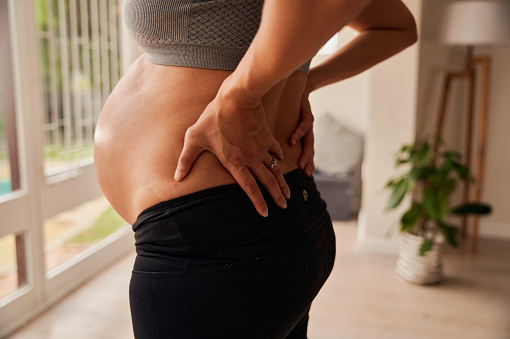Some women may develop pelvic pain during pregnancy. This is sometimes called pregnancy-related pelvic girdle pain (PGP) or symphysis pubis dysfunction (SPD). PGP is a collection of uncomfortable symptoms caused by stiffness of your pelvic joints or the joints moving unevenly at either the back or front of your pelvis. though extremely debilitating, it is rarely harmful to the growing fetus and almost always disappears after delivery. In this blog post, you will get some insight into the causes, danger signs, and management tips for pelvic pain.
Understanding pelvic pain during pregnancy: 10 common causes

Pelvic pain may occur due to a variety of reasons, some are serious and others not so much. Let’s know about the common type of pelvic pain during pregnancy:
- Symphysis pubis dysfunction or Pelvic girdle pain (SPD or PGP): The pelvic girdle is joined in front and this joint is called the symphysis pubis. As soon as conception happens, levels of hormones like progesterone, estrogen, and relaxin rise in the blood leading to instability and laxity of this joint. This dysfunction increases as the pregnancy advance and leads to pelvic pain.
- Accommodation pain: This happens in the first trimester due to the expansion of the uterus. It feels like cramps but until there is no bleeding there is no need to be alarmed.
- Round ligament pain: A sharp pain might be felt in the second trimester due to stretching of the round ligament which extends from the uterus to the groin. There is nothing to be alarmed about in this situation.
- Diastasis recti: This is extremely common in pregnancy and occurs due to the separation of the rectus abdominous muscle (the six-pack abs muscle) due to the pressure from the growing uterus. It gets better after delivery, especially with the aid of certain exercises.
- Pressure due to growing fetus: Occurs late in pregnancy when the baby starts gaining fat and starts to gain weight. This pain typically occurs due to the impingement of various nerves that are there in the region. It can get exaggerated on movement.
- Ovarian cysts: Cysts in the ovaries can either form or grow in size owing to the hormonal upsurge in pregnancy. Though mostly benign and harmless, they can be painful and the pain can be exaggerated if they burst.
- Braxton Hick’s contractions: These contractions are also called ‘false labor pains’ and may not actually be painful but just feel like pressure or tightening. They usually occur in the second and third trimesters and can be triggered by dehydration. They are self-limiting but if they come in fixed intervals then it might be a sign of actual labor.
- Urinary tract infection (UTI): UTI may present with a sudden urge to urinate followed by a burning sensation while urinating, accompanied with or without abdominal pain. Though, seemingly harmless untreated UTI may infect your kidneys and precipitate pre-term labor. It is important to get urine tested frequently during pregnancy as it is easier to treat during the initial stage.
- Constipation: A relatively common complication in pregnancy may affect as many as half the women. It occurs due to hormonal changes and iron supplements that slow down the digestion process.
- Vulvodynia: Chronic pain in the pelvic region, especially in the vulvar and vaginal region without any obvious cause is called vulvodynia.
What % of women suffer from pelvic pain?
1 in 5 pregnant women suffers from pelvic girdle pain. Though painful, pelvic pain due to the above-listed common causes does not generally harm the baby.
11 ways to get relief from pelvic pain

Tell your midwife or doctor about your pain. You should be offered an appointment with a physiotherapist who will make an assessment to diagnose pelvic girdle pain. This will involve looking at your posture and your back and hip movements and ruling out other causes of pelvic pain. The following simple measures may help:
- Keeping active but also getting plenty of rest
- Standing tall with your bump and bottom tucked in a little
- Changing your position frequently and try not to sit for more than 30 minutes at a time
- Sitting to get dressed and undressed to avoid putting pressure on one side of the pelvis
- Putting equal weight on each leg when you stand
- Trying to keep your legs together when getting in and out of the car
- Lying on the less painful side while sleeping
- Keeping your knees together when turning over in bed
- Using a pillow under your bump and between your legs for extra support in bed.
- Appointment with a physiotherapist: An appointment with the physiotherapist will put into perspective a lot of things like avoiding certain movements, best positions, pacing your activities, and the correct way of doing exercises. You may be offered more specialized treatments like manual therapy, warm baths or packs, hydrotherapy, and acupuncture.
- Support belts: Maternity support belts are specifically designed belts meant to provide comfort and support to pregnant women. These belts help to relieve pressure on the back, abdomen, and pelvis. Make sure that the belt fits snugly but comfortably, with no tightness or chafing. It is also important to avoid over-tightening or wearing the belt too high up on the abdomen as this can cause compression of nerves and blood vessels, leading to pain or other complications.
6 activities to avoid that may make pelvic pain worse:

- Lifting anything heavy, for example, heavy shopping
- Going up and down the stairs too often
- Stooping, bending, or twisting to lift or carry a toddler or baby on one hip
- Sitting on the floor, sitting twisted, or sitting or standing for long periods
- Standing on one leg
- Crossing your legs
Can pelvic pain be dangerous?
Though not generally dangerous, pelvic pain should ring an alarm bell if the pain is accompanied by bleeding (miscarriage, ectopic pregnancy, placental abruption), or the pain is persistent for more than 2 hours and comes in waves (pre-term labor), or is excruciating in nature (uterine rupture, ovarian torsion).
10 symptoms to watch out for:

You should contact your midwife or doctor immediately if you have any of the following symptoms:
- Pelvic pain that you can’t walk or talk through
- Fever and/or chills
- Any bleeding
- Severe headache
- Dizziness
- Sudden swelling of the face, hands, and/or feet
- Persistent nausea and/or vomiting
- Fewer than 10 fetal kicks in one hour (any time between 30 weeks and delivery)
- More than four contractions an hour for two hours
- Watery, greenish, or bloody discharge
Conclusion
For most women, early diagnosis and treatment should stop symptoms from getting worse, relieve your pain, and help you continue with your normal everyday activities. It is therefore very important that you are referred for treatment early. Pelvic pain is not something you just have to ‘put up with’ until your baby is born.

Akanksha Sharma
Dr. Akanksha Sharma, Head Writer and creator of AtoZ of Pregnancy, is dedicated to empowering women, parents, and families through 360-degree knowledge. She and her team provide evidence-based advice to guide families through pregnancy, parenting and beyond.






